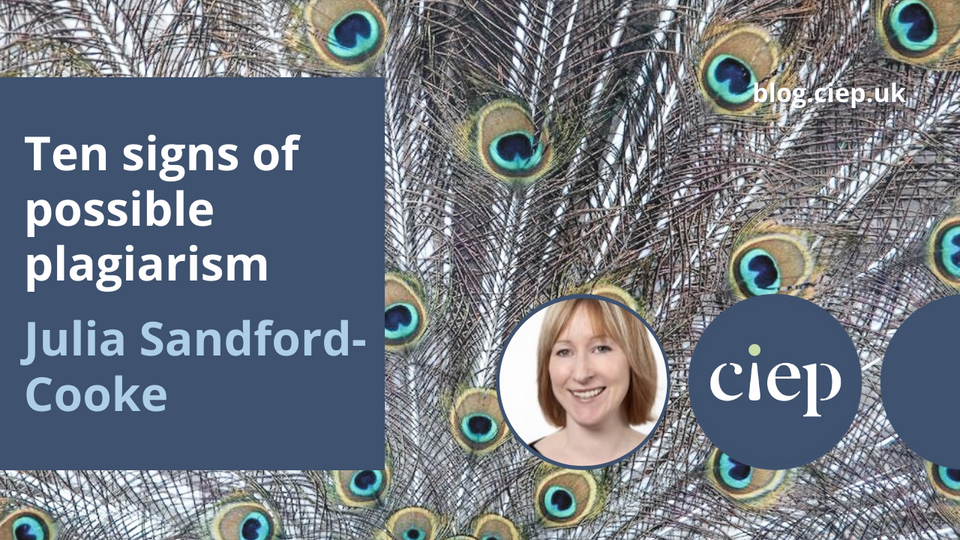Plagiarism in textbooks and other non-fiction resources is easily overlooked during production – but picking it up after publication is too late. Julia Sandford-Cooke raises some red flags that might suggest an author has copied their content from the web, and suggests some next steps if you think text is being reused without permission.
Plagiarism is a common problem in non-fiction texts – and probably in fiction texts as well but, as that’s not my specialism, this post focuses on non-fiction content, specifically text copied from websites.
If authors have been commissioned by a publisher, they will have been briefed about the importance of avoiding plagiarism. However, publishers often don’t have processes in place, or the budget to buy software, to check whether content is original. It may not be part of the development editor’s, copyeditor’s or proofreader’s brief to check for plagiarism (exactly who has this responsibility is beyond the scope of this post) but, ethically, you should be aware of signs of copying – and your client will be very grateful if you pick up plagiarism before the resource is too far down the line.
Why might authors plagiarise?
You may have seen headlines about plagiarised text in cookery books and even memoirs, but I think it’s rare for an author to deliberately plagiarise content. Text is more likely to be inadvertently copied.
It’s very easy to simply copy and paste text from a website into a Word or Google document. Authors may do so while carrying out research, and then forget to change the wording when they use it in their book or article.
Some authors believe that text copied from the internet is not covered by copyright laws – but it certainly is! Experienced authors sometimes reuse their own text that has been published elsewhere but normally (at least in educational publishing) the original publisher retains the rights to this text, so a different publisher cannot reuse the same text without permission, even if the author is the same.
Other authors may think that copied text comes under the ‘fair use’ rule of thumb, in which short excerpts don’t need permissions clearance, but this only covers content that is clearly presented as a quotation or excerpt, with a proper citation – not unattributed text taken from elsewhere without acknowledgement.
Ten possible plagiarism red flags
If you are working in Word, turn on Invisibles (click ¶ on your Word Home toolbar).
Content may have been copied from the internet if you spot some of the following:
- Non-breaking spaces (°) where you wouldn’t expect them. Authors rarely consciously use these in original content; however, it’s not always a sign of copying. For example, if the document has already been edited, you may see non-breaking spaces legitimately used between numbers and units (eg 2°km) to stop them being separated by breaking over a line. Otherwise, regard them as a warning sign.
- Soft returns (
 ) instead of hard returns or paragraph marks (¶). Again, it’s unlikely that authors would deliberately use these, unless they are confident in working with highly formatted content. Web tools, however, often convert hard returns into soft returns when formatting in HTML.
) instead of hard returns or paragraph marks (¶). Again, it’s unlikely that authors would deliberately use these, unless they are confident in working with highly formatted content. Web tools, however, often convert hard returns into soft returns when formatting in HTML. - Random and irrelevant hyperlinks that may be hidden by reformatting – hover your mouse over the text to reveal them. You could right-click to reformat the link in the usual blue, underlined style, to draw attention to it.
- A sudden switch from UK- to US-style punctuation or vice versa (for example, from using spaced en rules to using unspaced em rules – see Example 1 below).
- Sudden, inconsistent use of -ize spellings if the prevailing style is -ise spellings. It can be an indication that content has been copied from an American website. Of course -ize spellings are acceptable in UK style but most British authors would choose -ise spellings, unless their specialism is, for example, business or economics. In any case, it is the inconsistency that raises the red flag here.
- Sudden, inconsistent use of capitalisation that differs from the author’s previous style (eg Principles of Management, the Client).
- Content that isn’t quite relevant or is too vague. In Example 1, the key term should have been ‘demographic movement’, as specified in the syllabus.
- A sudden change in style or tone, for example using more complex grammar or technical words that have not been used before, or a colourful turn of phrase that seems out of character.
- Marketing-speak in what should be objective content (see Example 2).
- Specific facts, figures and statistics – if they seem odd or out of date, check them online (for example, when text that was supposedly written recently mentions a scheme launched four years ago as if it were new).
Example 1
Supplied text: ‘Key term: Demography is the study of the growth, structure, and movement of human populations. It focuses on enumerations (censuses), which take stock of a population at a moment in time, and also flows of vital events—births, deaths, marriages, and migratory movements.’
Giveaways: Change in tone; author hasn’t previously used the Oxford comma; sudden inclusion of an unspaced em rule; content not quite relevant to surrounding text; key term should be ‘demographic movement’, not ‘demography’. Pasting the text into Google reveals an exact match to Encyclopedia.com, including the punctuation. Although it could be argued that this short extract is ‘fair use’, a word-for-word mapping to a definition is not ideal.
Comment to the author: This text is copied from Encyclopedia.com. Please can you rewrite it in your own words, and also consider relating more directly to demographic movement, to clarify the concept for learners?
Example 2
Supplied text: ‘Government funding for new business start-ups has no age limits. Any creative entrepreneurs with fantastic ideas, determination and solid business plans can apply for loans to help them get started. Remember you have to repay the money, with interest, over terms of up to five years. Over 10,000 businesses have taken advantage of these start-up loans since the scheme was launched in May 2012. Will you be next?’
Giveaways: Sudden change from a formal tone to a chatty marketing tone, which addresses the reader directly; reference to launch year implies it was recent when the text was written; figure of 10,000 possibly low for a ten-year period.
Comment to the author: This text is very marketing-orientated and seems to have been taken from [website]. Please amend it to take it further from the source material, and include some more recent figures.
Next steps if you suspect plagiarism
What should you do if you spot enough of these warning signs to make you suspect that some of the content is plagiarised from the web?
First, check for yourself: copy and paste suspect text into Google then, if it matches or nearly matches a source, note the link.
Reword the text if that’s the most efficient solution, or if you think the author won’t be able to do so within the time available, but do let them know.
Be polite but direct when telling authors they have plagiarised content – they will probably know it’s wrong and that they are guilty, especially if you can provide the exact URL they’ve used. I’ve had responses ranging from mortification to ‘It’s a fair cop! I’m impressed you noticed!’ but no author has refused to reword their text under these circumstances.
If you are working for a publisher, inform your in-house contact. Keep your report objective – state that you have identified some possible instances of plagiarism that you’ve marked up (or amended) and discussed with the author. Of course, if huge chunks of text have been copied, inform the publisher immediately so they can take steps to rectify it, minimising the impact on the budget and schedule.
Whatever the case, don’t ignore the problem. Section 3.1.3 of the CIEP Code of Practice states: ‘Members should be familiar with the main provisions of the current relevant legislation … in particular relating to … the reproduction of copyright material belonging to third parties. They should endeavour to ensure that these provisions are adhered to and bring any suspected infringement to the attention of the client.’
Even if it’s not technically your job to spot plagiarism, you have a duty to draw attention to it.
About Julia-Sandford Cooke
 Advanced Professional Member and CIEP Information Team member Julia Sandford-Cooke of WordFire Communications has clocked up nearly 25 years in publishing. When not editing textbooks, she posts short, grumpy book reviews on her blog, Ju’s Reviews, and would like to get on with writing her novel if only work didn’t keep getting in the way.
Advanced Professional Member and CIEP Information Team member Julia Sandford-Cooke of WordFire Communications has clocked up nearly 25 years in publishing. When not editing textbooks, she posts short, grumpy book reviews on her blog, Ju’s Reviews, and would like to get on with writing her novel if only work didn’t keep getting in the way.
 About the CIEP
About the CIEP
The Chartered Institute of Editing and Proofreading (CIEP) is a non-profit body promoting excellence in English language editing. We set and demonstrate editorial standards, and we are a community, training hub and support network for editorial professionals – the people who work to make text accurate, clear and fit for purpose.
Find out more about:
Photo credits: peacock feather by Magda Ehlers and mountain by Chris Czermak, both on Pexels.
Posted by Julia Sandford-Cooke, CIEP information commissioning editor.
The views expressed here do not necessarily reflect those of the CIEP.



I once reviewed a paper for a conference, and found a section of it had very familiar text. I quickly found that it had been copied from a paper that I myself had written, with only insignificant changes.
Another tell-tale sign: a mixture of straight and curly quotes (or apostrophes).